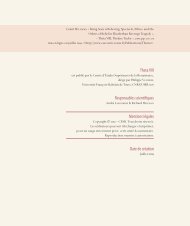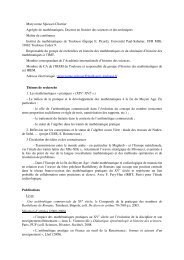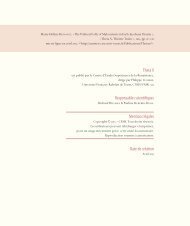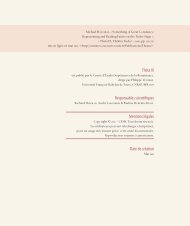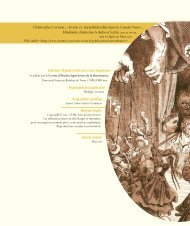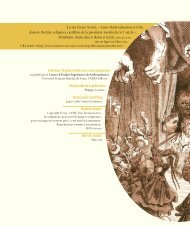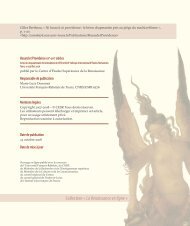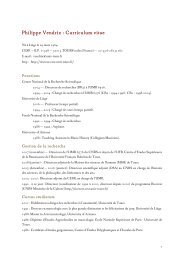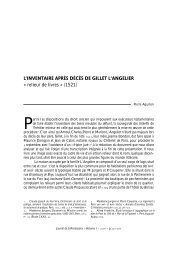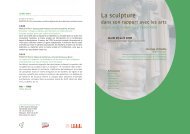Theta IX Responsables scientifiques Mentions légales Date de ...
Theta IX Responsables scientifiques Mentions légales Date de ...
Theta IX Responsables scientifiques Mentions légales Date de ...
Create successful ePaper yourself
Turn your PDF publications into a flip-book with our unique Google optimized e-Paper software.
the agents of God’s judgement. In the Thrie Estaitis, Divine Correction is sent byGod as a superior King to awaken King Humanitie to his shortcomings and thento support him in his rule. But Nemesis, the “god<strong>de</strong>sse of correccion” (l. 8) inRespublica, is i<strong>de</strong>ntified with the queen herself, with the effect of emphasising therole of the monarch as God’s representative on earth. These conceptions of thestrengths and weaknesses of the monarch, the powers and limitations of kingship,are not openly discussed, but they are embodied and performed as markedlydifferent in each play.There are some obvious contextual reasons for these striking differences inthe performed portrayal of royal power. The plays are <strong>de</strong>signed for very differentaudiences. Respublica seems to be a Christmas court performance by a boys’ company,probably drawn from the Chapel Royal. The public Edinburgh productionof the Thrie Estaitis played to an audience which drew together court and burgh,ranging across all classes. It is hardly surprising that the view of royal power inthe Edinburgh performance is more complicated and qualified than the moreunivocal celebration and reverence of the London court. Beyond their overtsimilarities as newly invested Roman Catholic female rulers, the different positionsof the two queens are also influential. Mary Tudor came to the throne on awave of popular support as the rightful heir, with a clear personal commitmentto restore Roman Catholic practice to a country that was technically Protestant.Mary of Guise had won the regency from the Earl of Arran only after long andcareful negotiation, and was reigning as proxy for an absent child monarch, in acountry where religious reform was not yet official and sha<strong>de</strong>s of opinion weredivi<strong>de</strong>d and often unclear.But arguably, what we see embodied in the two performances is not justthese specific contextual circumstances, but what had become broa<strong>de</strong>r formulationsof i<strong>de</strong>ologies of monarchy in the two countries. Fifteenth- and sixteenthcenturydiscussions of kingship shared many conventional positions about thepowers and responsibilities of the monarch in relation to God and to the State.Traditionally, the prime duties of the king were to protect the realm, to administerjustice and to govern for the good of his people. His allegiance should be toGod, from whom he <strong>de</strong>rived his power, but he should accept the importance ofgood counsel. During the first half of the sixteenth century these basic tenetsremained central, but they came to be rather differently inflected in Englandand in Scotland. In England, largely in response to the personal and constitutionalstrategies of Henry VIII, increased emphasis was placed on the primaryDramatising I<strong>de</strong>ology …theta iX 107



